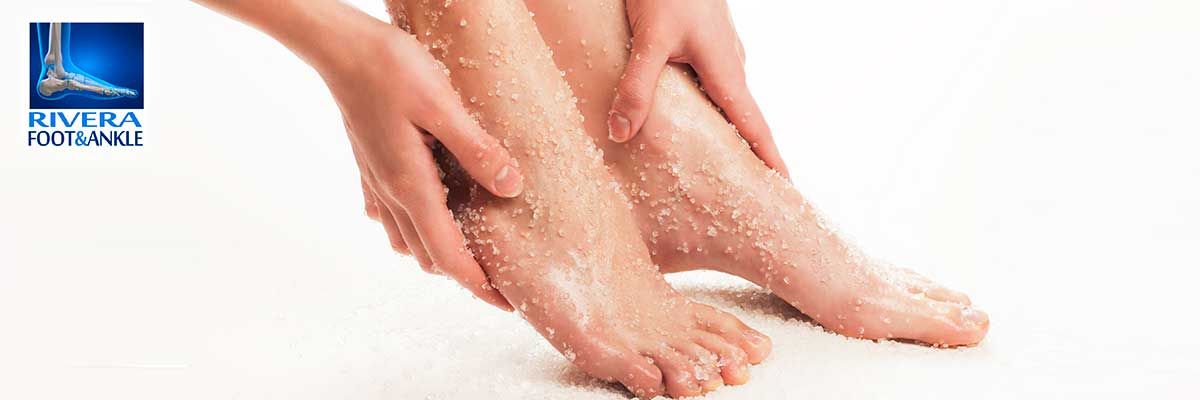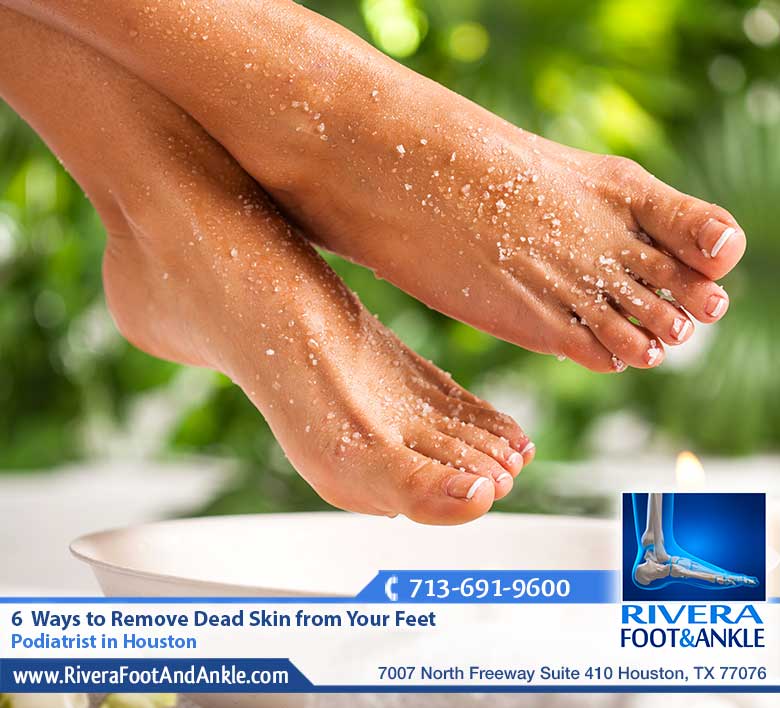
Podiatrist in Houston
6 Ways to Remove Dead Skin from Your Feet
What causes dead skin on the feet?
Dead or loose skin forming on the feet is your foot’s way of naturally exfoliating and shedding dead skin cells.
Dead skin can build up because of a lack of moisture if your feet are constantly in closed shoes or socks, or from the friction of walking or running. It can also form if you don’t regularly care for, exfoliate, or scrub your feet.
Dead skin on the bottom of your foot may appear dry, cracked, or loose or hanging. It’s usually not painful unless it’s a result of athlete’s foot, eczema, or another type of infection.
If you suspect that’s the case, see your doctor for treatment. Otherwise, you may want to remove dead skin for cosmetic reasons or because it’s more comfortable.
Here are some options for removing dead skin.
- Pumice stone
A pumice stone is a natural lava stone that can help remove dead skin and callouses from your feet.
To use:
- Dip the pumice stone in warm water. You can also soak your feet in warm water for 10 minutes to soften them.
- Gently move the stone in a circular or sideways motion around your foot to remove dead skin. Focus on removing the top layer of the skin and not the entire area of dead skin, which will help promote healthy cell turnover.
- Apply lotion or oil afterward to help soften your feet.
Never use a pumice stone on injured or sore areas.
- Paraffin wax
Many nail salons offer paraffin wax as an add-on for a pedicure treatment.
Paraffin wax is a soft wax that’s melted at a medium temperature of around 125°F (51°C). The wax shouldn’t be hot enough to burn or irritate your skin.
Do not use paraffin wax if:
- you have poor blood circulation
- you have a rash or open sore on your feet
- you’ve lost feeling in your feet, such as from diabetic neuropathy
If you use paraffin wax at home, be very cautious and monitor the temperature of the wax with a candy thermometer.
- Foot scrub
Most pharmacies and drug stores sell different foot scrubs over the counter. Look for one with granules that will help scrub away dead skin.
Or, you can even make your own by diluting two tablespoons of sea salt into equal amounts of baby oil and lemon juice.
To use a foot scrub, apply the scrub directly to your foot and rub gently with your palm. Or use with a foot scrub brush or sponge to remove dead skin.
Rinse scrub thoroughly with warm water after use.
- Oatmeal scrub
You can use oatmeal to make an at-home exfoliator to remove dead skin.
To make the scrub, mix equal parts oatmeal with rose water or milk to make a paste. To use:
- Apply the scrub to your feet and let set for up to 20 to 30 minutes.
- Use a foot brush to exfoliate your feet.
- Rinse with cold water and let your feet dry.
- Apply a foot cream.
Perform this treatment every other day for best results.
- Epsom salt soak or scrub
Epsom salt is a crystal form of magnesium sulfate. Magnesium sulfate is a mineral compound.
You can soak your feet in Epsom salt that’s dissolved in water. It can help exfoliate and smooth dry, cracked feet. This, in turn, may help remove dead skin.
To use:
- Create an Epsom salt soak by pouring 1/2 cup of salt into a footbath or a full cup into a bathtub full of warm water.
- Relax and soak for up to 20 minutes.
- You may use a pumice stone or foot brush after to help remove dry skin.
To create an Epsom salt scrub for your feet, in the shower or bath, mix a handful of Epsom salt with a tablespoon of bath or olive oil in your hand or on a bath sponge.
Rub gently over wet skin to exfoliate, soften, and remove dead skin before rinsing off with water.
- Vinegar soak
Vinegar soaks may help soften feet and allow you to remove dead, dry, or cracked skin.
- You can use almost any type of vinegar. Apple cider vinegar or white vinegar are popular options, and you may already have them in your kitchen.
- Use cool water to create the soak, as hot water may dry out the skin more. Use 1 parts vinegar to 2 parts water as a general guideline. Soak feet for 5 to 10 minutes to start.
- If desired, follow the soak by using a pumice stone to remove dry or loose skin using the guidelines above. Apply moisturizer, petroleum jelly, or coconut oil before putting on socks to seal in moisture after doing a vinegar soak.
Only do this treatment a few times a week as it can be further drying on the skin.
RIVERA FOOT & ANKLE: At Orlando H.Rivera DPM, our priority is to deliver quality care to informed patients in a comfortable and convenient setting. When you have problems with your feet, you need to turn to a podiatrist who listens and responds… an experienced doctor who knows the field and can effectively diagnose and treat your needs… a friendly physician who counsels you on the best ways to maintain and improve your health. Our physician(s) meet all these criteria. Plus, you benefit from a dedicated team of trained professionals who give you the individualized attention you deserve.

Podiatrist in Houston
Foot and Ankle, Dr. Orlando Rivera, Advanced Foot & Ankle Specialist, Foot and Ankle Podiatry, Houston Foot & Ankle Surgical, Treatment of Foot and Ankle, Foot & ankle specialists, Podiatrist in houston, podiatrist in houston, Orlando H.Rivera DPM, Houston Foot Doctor, Foot and Ankle Surgeon Houston, Ankle and Foot Specialist Houston, Podiatrist Houston, Foot Pain Houston.



